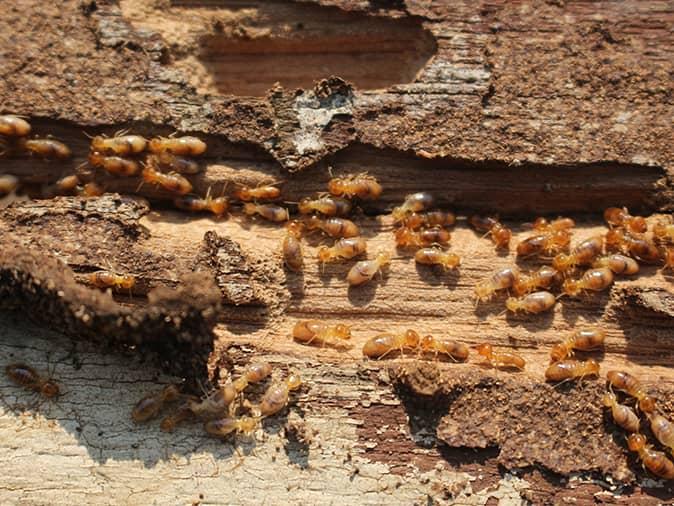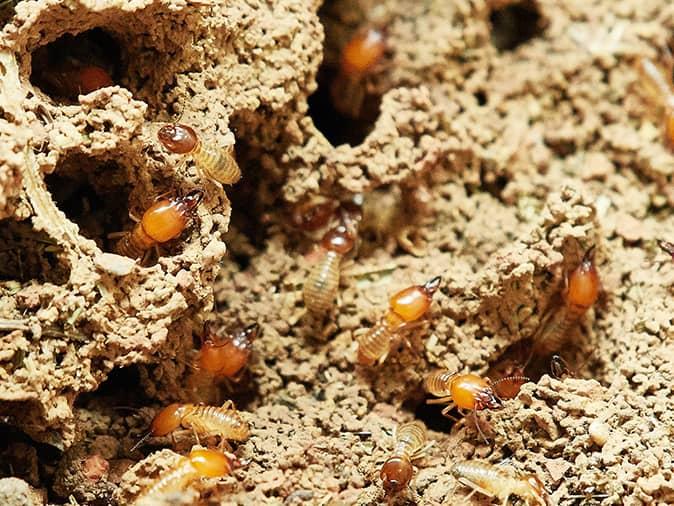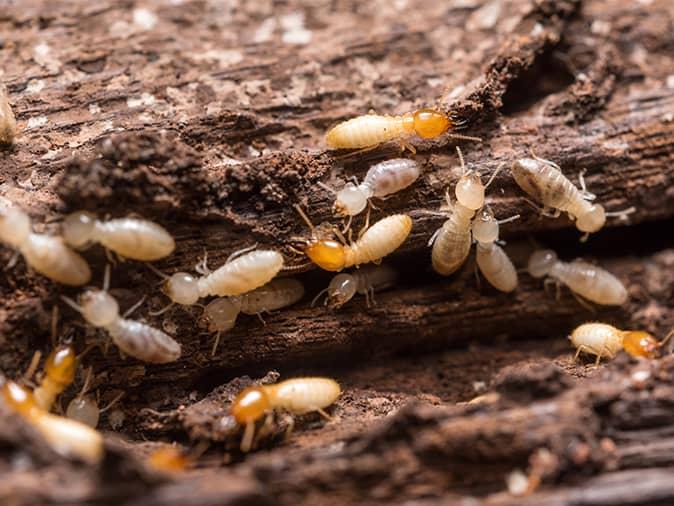Protecting Your New Jersey Home From Termite Damage
Out of sight, out of mind. That pretty much sums up subterranean termites, which are the most destructive wood-destroying pest in the United States. Subterranean termites are more destructive than carpenter ants and bees, woodboring beetles, and even other termite types such as drywood and dampwood termites. Worker termites in the classification of subterranean termite, never see the light of day. They live exclusively in dark places. This makes it difficult to detect them when they come to destroy our property by the thousands or hundreds of thousands. And, when the damage they do is finally recognized as termite damage, unseen damage is often extensive. That is why it is so important to know what termite damage looks like, as well as all of the many things these termites consider to be food.
In a article we wrote for termite awareness week, we touched on how important it is for home and business owners to be aware of the significant threat subterranean termites pose and why everyone should take part in termite awareness week. With this article, our intention is to go into greater depth regarding the kind of damage termites can cause when they come onto our property. Whether you own a home or a business, this information should help you better understand this threat and guide you in your understanding of what measures are necessary to guard against extensive subterranean termite damage.

Termite damage
Subterranean termite workers can travel as much as the length of a football field in search of food. This can bring many termite colonies in contact with your home at the same time. A termite infestation doesn't mean one colony has infested your home. It is important to understand this when considering how residential termite damage can occur, and more importantly, where it can occur.
Termite Damage Outside Your Home
In and around your yard, there could be many food sources for termites. They can feed on a shed, outbuilding, wood border around a flower garden, firewood, construction materials, tree stumps, and other wood products. They are drawn to wet wood and dead or dying wood. However, wood is not all that termites eat and they will also feed on the vegetables in your garden.
How do I know if I have termites around my home?
If you have termites feeding on items in your yard, there are two reasons you're not likely to see them doing it. Worker termites die when they get dried out and they do not like the light. You'll need to chop into a stump or dig into the soil around a fence post to see worker termites. Learn the warning signs
Damage inside your home
When termites get into a home they feed mostly on the wooden structures your home provides, including your home itself. They will tunnel through support beams, timbers in load-bearing walls, as well as plywood, sheetrock, and more. Most of this damage will be unseen and our professionals need special equipment to track them down in your walls. If you see paint bubbling, honeycomb indentations on baseboards, ceilings sinking down, or general damage that looks like water damage, be aware that it may be termite damage.
- Subterranean termites may also damage furniture, books, fabrics, magazines, and other objects that have cellulose in them. They tunnel up from the floor or out from a wall, under the cover of darkness, to feed on these objects. They won't eat your curtains if they're hanging on a curtain rod, but they'll be more than happy to eat them if they are piled on the floor.
- If they can't get to a food source without going through the open air and being exposed to the light, they will create shelter tubes. Recognizing a shelter tube is key to termite prevention. These tubes are made from the soil outside of your home, so they will be the same color. They can be as thin as a pencil or as thick as your leg, depending on many factors.
- When subterranean termites feed on a home, they can cause secondary damage by creating openings for rainwater to enter. And, as moisture pests, subterranean termites prefer damp wood. Water damage can actually increase the amount of damage these termites will do. It will also present other issues, such as exposing electrical wires to the elements.
Termite damage and water damage are both catalysts for secondary pest infestation. There is a wide range of pests that can damage your home and your belongings. As mentioned above, termites aren't likely to damage hanging curtains, but it is important to understand that secondary pests will.
What termite damage looks like in commercial facilities

While subterranean termites cause the same damage to commercial structures and belongings as they do residential structures, commercial structures have their own unique challenges when it comes to dealing with these pests. Businesses tend to be larger and more complex than a single family home both in structure and operation.
When subterranean termites attack a large structure, it can take longer for damage to be noticeable. Worker termite do not feed on one area until it is completely consumed. They feed on multiple points. This can lead to significant and unexpected repair costs for a business because it can take many years for the damage to become visible.
In a business environment, termites can come out of the most unexpected places and feed on some of the most unexpected things. If you have a cement foundation, it may be startling to see hundreds of swarmers come flooding out of a hole, but it can happen. Subterranean termites can live deep under the ground, below the frost line, and come up underneath a concrete slab. If there is the tiniest hole or crack, these insects will find it. When they do, they'll feed on wood pallets, stacked paper and textiles, stored vegetables, potted plants, cardboard containers or stacked cardboard, furniture, and more. Any product that has cellulose is at risk for termite damage.
When termites damage the structure of a business or the objects inside a business, it has a negative financial impact. The structure must be repaired, stored products must be replaced, and the reputation of the business often has to be repaired as well. Every commercial pest management plan should include termite protection.
Termite Protection Is Essential For NJ Homes & Businesses
There are many ways subterranean termites can do damage. While they are best known as wood-destroying insects, their destructive impact goes far beyond. That is why it is essential for every home or business owner to invest in a long-term termite control solutions that comes with a warranty.
If you have not yet taken this step to protect your property, reach out to Arrow Pest Control. We'd be happy to address your questions or schedule a free termite estimate.
Providing termite control in Montclair, Short Hills, and Clark as well as throughout our New Jersey service area, our team of local pest control professionals are ready to help you identify termite damage and get rid of termites!
Other dangers termites present

Along with serious structural damage and the destruction of personal belongings, subterranean termites present other dangers for home and business owners. Some of them may surprise you.
Bites
Termites are able to bite humans and pets, though it is rare, and these bites are not life-threatening. If a termite bites, the wound will only be an itchy welt. Contact between termites and other living creatures within a home or business usually occurs when termites go from walls to piles of stored goods, especially clothing. If a dog or cat makes a bed in items that are infested by termites, bites can happen.
Allergies
The particles and dust created by termites can irritate individuals who suffer from asthma or other allergies. The saliva and droppings from termites can also cause dermatitis when they come in contact with the skin. When fluids from termites get into air ducts, it can cause airborne allergens. This is a particular threat to any individual with a compromised immune system.
Mold
When subterranean termites create channels for water or moisture to get into a man-made structure, it can lead to wood rot and cause other moisture problems to develop. One moisture problem that can present a major health issue is mold. The symptoms of mold range from sneezing, coughing, stuffy nose, post nasal drip, and itchiness to wheezing, chest tightness, shortness of breath, and other serious medical complications. Beyond the medical implications, mold is a frustrating problem that can be costly to address. The mold must be cleaned off of all surfaces, even in wall voids, and the air must be scrubbed.
Food Rot
When subterranean termites chew through 2x4s and paint and work their way into cardboard boxes, they can sometimes chew all the way to stored food products. While termites can eat some stored foods, the greatest danger is food rot. When moisture gets into any food source, it will cause that food to rot. This rotting is likely to occur at the bottom or near the back of the container where termites have penetrated, making it difficult to detect the contamination at first.
Crops
Though subterranean termites are considered a wood-destroying insect, there are many crops that termites find interesting. It is usually crops that have a high cellulose content, such as corn, coffee, cotton, peanuts, soybeans, and more. They are also known to feed on fruit trees. For some businesses, structural protection is only one part of a termite control plan.
Arrow Premier
If you’re looking for a program that protects your home and family from common household pests PLUS termites and other wood-destroying insects, we recommend Arrow Premier. With this program, you get quarterly pest control and a wood-destroying insect program in one package!
- Protects your home all year long.
- Consists of full interior and exterior inspections and treatments.
- Covers your entire property* including the attic, mailbox, play set, shed, and fence.
- Includes a certified termite inspection and ongoing termite control.
Pests targeted with Arrow’s Premier includes cockroaches, silverfish, spiders, earwigs, clover mites, millipedes, centipedes, crickets, ground beetles, boxelder bugs, ants (including carpenter ants, pharaoh ants and acrobatic), fleas (inside only), pillbugs, sow bugs, fruit flies, stored product pests, bees, wasps, hornets, carpenter bees (no higher than 10ft), mice, and rodents PLUS termites
*If you have a pool house that requires service, pricing would increase based upon the size of the structure.


Testimonials
Request Your FREE Estimate
Additional Services
Our solutions are designed for even your toughest pest problems.
Don’t let pests affect your quality of life, here's how we can help:
